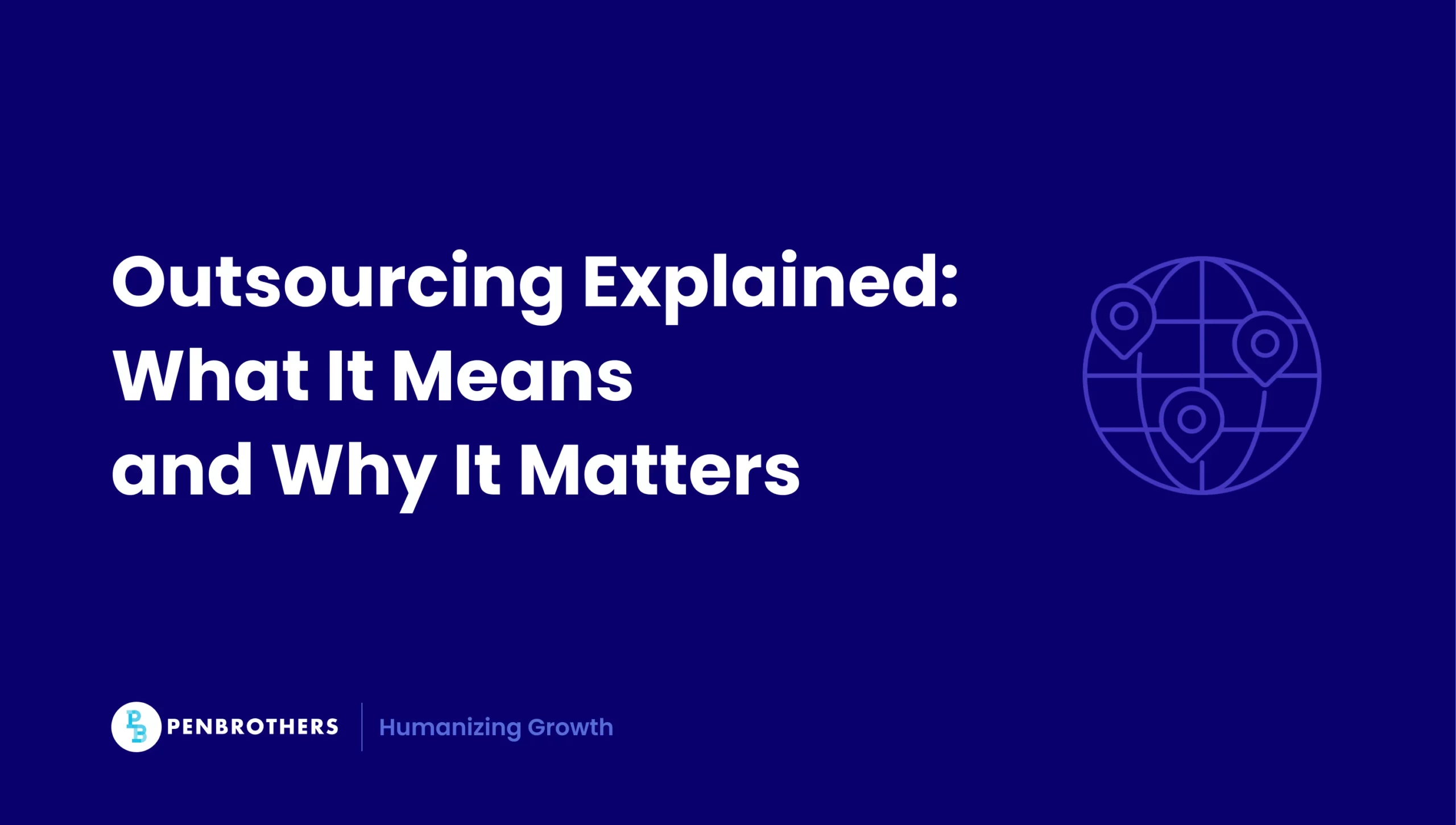What's Inside?
What Is Outsourcing? Why Fast-Growing Businesses Rely on It Today

Six months ago, you had a simple business. Make product, sell product, support product. Now you have forty-seven different software subscriptions, three recruiting agencies on retainer, and a company handbook that nobody reads. You spend more time putting out fires than building for growth. Your calendar is wall-to-wall interviews for roles that shouldn’t be hard to fill, somewhere between Series A and Series B, you stopped being a founder and became a middle manager.
Meanwhile, your competitor just announced their third product launch this quarter and is growing twice as fast.
The difference? They discovered outsourcing.
Not the call centers and data entry of the past, but integrated global teams that work while they sleep, specialized talent they could never afford locally, and systems that turn geographic distribution from a handicap into a superpower.
This is outsourcing in 2025. And once you understand how it works, you’ll wonder why you ever tried to do everything yourself.
Key Takeaways
- A Strategic Tool for Capability, Not Just Cost: Modern outsourcing has evolved beyond a simple cost-cutting tactic. It is now a strategic approach for businesses to gain a competitive advantage by accessing specialized global talent, achieving 24/7 operational speed, and scaling much faster than local hiring allows.
- Different Models for Different Needs: Outsourcing is not a monolithic solution. It is crucial to understand the different types, such as IT Outsourcing (ITO), high-value Knowledge Process Outsourcing (KPO), and operational Business Process Outsourcing (BPO), and to select the right geographic hub for the job (e.g., the Philippines for BPO, India for ITO).
- Success Requires Active Management, Not a Hands-Off Approach: A primary cause of outsourcing failure is treating it as a “fire-and-forget” solution. Success demands active management, especially in the first 90 days, with clear documentation, structured onboarding, and robust communication protocols to bridge cultural and time zone differences.
- The Future is Deeper Integration and Specialization: The outsourcing industry is moving toward deeper integration, where partners function like internal departments using the same tools and processes. AI is expected to amplify human capabilities, not replace them, which will increase the demand for providers with niche, industry-specific expertise.
What Is Outsourcing?
Outsourcing means paying another company to handle work you’d otherwise do yourself.
Simple enough. But like most simple ideas that reshape industries, the implications run deeper than the definition suggests.
The term “outsourcing” gained traction in the 1980s as American manufacturers increasingly built products overseas to cut costs. General Motors would design cars in Detroit but have parts manufactured in Mexico. Nike would create shoe concepts in Oregon but produce them in Vietnam.
But what started as a cost play evolved into something more sophisticated: a way to access capabilities and scale that simply didn’t exist domestically.
Today’s outsourcing looks nothing like those early manufacturing deals. Companies outsource everything from customer service to machine learning development. From basic bookkeeping to building entire product features. From answering phones to analyzing satellite imagery.
The shift happened when executives stopped asking “How can we do this cheaper?” and started asking “How can we do this better?”
Types of Outsourcing
Now, understanding the basics helps you speak the language when vendors come calling.
Geography determines your first set of options:
Onshoring keeps everything domestic. You hire a company in San Francisco to handle your San Francisco company’s needs. Safe, expensive, limited.
Nearshoring crosses borders but stays close. US companies hire Mexican firms. UK companies work with Polish developers. You get some cost savings, similar time zones, and cultural proximity.
Offshoring goes global. This is where the Philippines, India, and Eastern Europe enter the conversation. Maximum cost savings, massive talent pools, and yes, time zone challenges. But when you figure out how to make those time zones work for you, it becomes a superpower.
Function determines what you actually outsource:
IT Outsourcing (ITO) covers your technical needs. Not just developers, but architects, DevOps engineers, QA specialists, and data security experts. Companies like Spotify and Slack were built with significant ITO components.
Business Process Outsourcing (BPO) handles operations. This is the engine room stuff: accounting, HR, customer support, data entry. The work that keeps your business running, but doesn’t define what your business is. Luxclusif outsourced its entire back-office operation to the Philippines and cut costs by 78% while its core team focused on growth.
Knowledge Process Outsourcing (KPO) brings in the specialists. Investment research, legal analysis, medical transcription, architectural design. High-skill work that requires expertise, not just execution. When Propeller Aero needed specialized GIS analysis, they didn’t hire locally. They built a team in the Philippines with exactly those skills.
Human Resources Outsourcing (HRO) manages your people operations. Everything from recruitment to benefits administration to compliance. Ironically, many companies outsource the very function that helps them build teams.
Finance and Accounting Outsourcing (FAO) keeps your books straight. From basic bookkeeping to CFO-level financial strategy.
Customer Service Outsourcing fields your customer interactions. But modern customer service goes beyond call centers. It includes technical support, social media management, community moderation, and success management.
What Is Business Process Outsourcing (BPO)?
Let me tell you why BPO deserves its own section.
BPO is where some companies start their outsourcing journey and where the biggest transformations happen. It’s also where the Philippines absolutely dominates.
Think of BPO as outsourcing your business machinery: the essential, repetitive processes that eat time but don’t create competitive advantage. Invoice processing. Data entry. Customer support tickets. Appointment scheduling. The stuff that needs to happen for your business to function, but doesn’t need to happen in your office.
The Philippines has turned BPO into an art form, not just providing cheap labor, but building an entire ecosystem around business process excellence. Universities offer BPO-specific degrees. Companies compete on quality metrics that would make Six Sigma consultants weep with joy. Here, customer service isn’t merely a fallback career. It’s a profession with advancement paths, specializations, and genuine expertise.
I’ve seen companies hand over their entire customer support operation to a Philippine BPO company and see satisfaction scores increase. Because when you give work to people who’ve made that work their specialty, who’ve built systems and training programs specifically for it, who approach it as a craft rather than a chore, quality follows.
Why Do Companies Outsource?
They’re drowning and need a lifeline. I see this constantly. A startup closes Series A funding, demand explodes, and suddenly they need twenty people yesterday. Local hiring would take six months and burn through their runway. Outsourcing gets them operational in weeks.
They’ve done the math and it’s not even close. A senior developer in San Francisco costs $200K plus benefits, equity, and office space. The same skill level in Manila costs $40K all-in.
They want to operate like it’s 2025, not 1995. Modern companies don’t shut down at 5 PM. They run 24/7, across time zones, with work following the sun. Your Philippine team handles overnight tasks. Your customers wake up to solved problems. Your competition wonders how you move so fast.
They’re testing something without betting the farm. Need to explore a new market? Spin up an outsourced team. If it works, scale it. If it doesn’t, wind it down.
They’re tired of managing operational tasks. Every hour your founding team spends on payroll processing is an hour not spent on product development. Every developer fixing customer support tickets is a developer not shipping features.
They need specialists, not generalists. You don’t need a full-time SEO expert, but you need SEO expertise. You don’t need a permanent QA team, but you need bulletproof testing. Outsourcing gives you access to specialists when you need them, without the overhead when you don’t.
Research from Deloitte confirms that the conversation has shifted from cost to capability. Companies want flexibility, speed, and access to skills they can’t find locally.
Risks and Challenges of Outsourcing
Outsourcing can fail spectacularly, and I’ve seen the wreckage.
Quality can crater if you’re not careful. The horror stories are plenty. Code that doesn’t compile. Customer service that infuriates customers. Accounting that doesn’t add up. Sometimes it’s the vendor’s fault: they oversold capabilities they didn’t have, cut corners you didn’t know existed, or simply lack the expertise they claimed. But just as often, quality fails because companies treat outsourcing like a hands-off solution. They throw work over the wall and expect miracles. They choose the cheapest bid without checking references. They skip onboarding because “these people are supposed to be experts.” The truth is, outsourcing success requires both sides to deliver, and proven systems in place to make the partnership last long-term.
Communication can break down completely. You’re dealing with 12-hour time differences, cultural communication styles, and the loss of hallway conversations. I’ve seen projects die because requirements got lost in translation, feedback arrived too late, and nobody wanted to admit they didn’t understand the assignment.
Security becomes a real concern. You’re sharing customer data, intellectual property, and trade secrets with teams you’ve never met in countries with different legal systems. One breach, one leak, one disgruntled employee with a USB drive, and you’re explaining to your board why customer credit cards are for sale on the dark web.
Hidden costs emerge from the shadows. The hourly rate looks amazing until you factor in management overhead, training investment, productivity ramp-up, and the tools needed to make remote collaboration work.
Dependency develops gradually, then suddenly. You start with customer support. Then add accounting. Then development. Then product management. One day, you realize your entire operation depends on a company 8,000 miles away.
Culture can slowly erode. Your company culture, carefully cultivated over years, can dilute when half your team has never set foot in your office, never met their colleagues in person, never experienced the intangibles that make your company unique.
These aren’t reasons to avoid outsourcing. They’re reasons to do it right. Every risk I’ve listed has a solution. Companies like Stripe, Canva, Spotify, and Slack haven’t avoided these challenges—they’ve systematically solved them.
The Global Outsourcing Industry Today
The global BPO market reached $302.62 billion in 2024. It’s projected to grow at 9.8% annually through 2030. That’s sustained, structural growth.
But each region has evolved its own specialization:
The Philippines owns customer service and back-office operations. It’s not just about English fluency anymore. Cultural alignment, service mentality, and an entire education system oriented toward BPO excellence matter more these days. When you need someone to represent your brand to customers or create compelling ads for your local market, the Philippines delivers.
India dominates IT outsourcing. Four million IT professionals, world-class technical universities, and decades of experience building software for global companies. If code needs writing, India’s your answer.
Eastern Europe is rising fast in fintech and blockchain. Close to Western European markets, strong technical education, and increasing specialization in complex financial systems. When you need sophisticated technical work with minimal time zone friction, look to Poland, Ukraine, and Romania.
Latin America serves as North America’s nearshore solution. Similar time zones, improving technical capabilities, and cultural affinity with the US market. Mexico, Colombia, and Argentina are becoming the go-to for companies that want offshore benefits without offshore distances.
Vietnam is emerging as the next big player. Lower costs than the Philippines, growing English proficiency, and heavy government investment in technical education. Watch this space.
Each region competed on cost initially. Now they compete on capability. Smart companies match their needs to regional strengths rather than just chasing the lowest bid.
The Future of Outsourcing
AI amplifies rather than replaces. Automation handles routine tasks, but it creates demand for human judgment, creativity, and relationship management. The Philippines is already shifting from basic customer service to AI training, quality assurance, and complex problem resolution. The work gets more sophisticated, not eliminated.
Hybrid models become standard. The rigid distinction between in-house and outsourced blurs. Your Philippine analyst joins standup meetings via Zoom. Your Serbian developer has the same Slack access as your local team, working as one unified team across borders.
Specialization accelerates. Generic outsourcing providers don’t grow as much as before because industry-specific expertise is where the demand is these days. Experienced executives won’t hire just another “BPO company,” they’ll hire “an offshore team that specializes in D2C e-commerce customer success.”
Integration deepens. The best outsourcing partners don’t feel like vendors. They feel like departments that happen to be in another country. Same tools, same processes, same culture, different time zone.
Ethics matter increasingly. Companies care about fair wages, working conditions, and sustainable practices. The race to the bottom on price ends. The race to the top on value begins. Partners who can prove they treat their people well win contracts.
The global talent cloud emerges. Geography stops mattering entirely for knowledge work. You hire the best person for the job, wherever they are. National boundaries become as irrelevant for hiring as they are for customers.
How to Decide if Outsourcing Is Right for Your Business
First, audit your current state:
What’s killing your productivity? List every task that talented people do reluctantly. Customer support tickets. Data entry. Invoice processing. Report generation. These are your quick wins.
Where are you weakest? Identify capabilities you need but can’t justify full-time. SEO expertise. Financial analysis. Technical documentation. These become your outsourcing targets.
What would you build with unlimited talent? Dream big. That AI feature. That 24/7 support. That content marketing machine. Outsourcing makes the impossible merely difficult.
Which processes could run while you sleep? Anything that doesn’t require real-time collaboration becomes a candidate. Code reviews. QA testing. Content moderation. Design iterations.
Then evaluate your readiness:
Can you document what good looks like? If you can’t explain success criteria, you can’t outsource successfully. Clear expectations prevent most failures.
Will you invest in making it work? Outsourcing isn’t passive income. It requires active management, especially in the first 90 days. If you’re not prepared to invest time upfront, wait until you are.
Can you handle the cultural bridge? Different communication styles, different approaches to hierarchy, different attitudes toward deadlines. If subtle cultural navigation frustrates you, stick to onshore.
Are you solving the right problem? Outsourcing amplifies what you have. It doesn’t fix what’s broken. Dysfunctional processes become dysfunctional at scale.
Your success checklist:
- Start small. Test with one function before transforming your entire operation. Learn what works in low-risk scenarios.
- Choose partners with frameworks, not just promises. Penbrothers’ Hypercare Framework exists because hope isn’t a strategy. Systems prevent what goodwill can’t.
- Document everything. Clear processes, recorded training, written feedback. Ambiguity is the enemy of outsourced success.
- Integrate immediately. The longer outsourced teams remain separate, the harder integration becomes. Make them part of your team from day one.
- Measure what matters. Not hours worked but outcomes delivered. Not tickets closed but customers satisfied. Not lines of code but features shipped.
- Invest in relationships. The best outsourcing feels like an extension of your team because it is. Regular video calls, virtual coffee chats, and yes, occasional in-person meetings.
Outsourcing is no longer just about cutting costs. It’s about building capabilities you can’t create on your own. The companies winning today aren’t outsourcing to do things cheaper, they’re outsourcing to do things better.
If you’re ready to explore how outsourcing can help you scale smarter, get in touch with Penbrothers today.
Frequently Asked Questions
These terms describe the geographic location of the outsourcing partner:
Onshoring: Partnering with a company located in your own country.
Nearshoring: Partnering with a company in a neighboring country, often with a similar time zone.
Offshoring: Partnering with a company in a distant country, typically to achieve maximum cost savings and access large talent pools.
BPO involves outsourcing core business operations, such as customer support, HR, and accounting.
KPO involves outsourcing higher-value, knowledge-based tasks that require advanced analytical and technical skills, such as investment research, legal analysis, or engineering design.
Beyond significant cost savings, the primary drivers are speed (the ability to scale teams in weeks instead of months), access to specialized talent that is difficult or impossible to find locally, and the ability to create 24/7 “follow-the-sun” operations to get products and services to market faster.
The biggest risks include a drop in quality if not managed properly, communication breakdowns due to time zone and cultural differences, data security vulnerabilities, hidden costs related to management and training, and an over-reliance on a single external provider.
Different regions have distinct specializations:
The Philippines: Is a global leader in customer service and back-office operations (BPO).
India: Dominates the IT outsourcing (ITO) market.
Eastern Europe: Is a top choice for complex, high-end software development.
Latin America: Serves as a primary nearshoring hub for North American companies due to time zone alignment.




